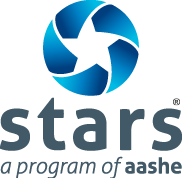| Overall Rating | Gold |
|---|---|
| Overall Score | 68.64 |
| Liaison | Kimberly Post |
| Submission Date | Feb. 22, 2022 |
Saint Joseph's College - ME
OP-1: Emissions Inventory and Disclosure
| Status | Score | Responsible Party |
|---|---|---|

|
3.00 / 3.00 |
Greg
Teegarden Faculty Science |
Has the institution conducted a GHG emissions inventory within the previous three years that includes all Scope 1 and 2 emissions? :
A copy of the most recent GHG emissions inventory:
A brief description of the methodology and/or tool used to complete the GHG emissions inventory:
Our GHG inventory was compiled from a revised version of the Clean Air Cool Planet tool, developed in collaboration with Second Nature and Riverstone Associates. Facilities Management at SJC tracks all Scope 1 and Scope 2 emissions, and Scope 3 emissions are reported as best estimates using survey and tracking tools for the main contributor, commuter emissions.
Has the GHG emissions inventory been validated internally by personnel who are independent of the GHG accounting and reporting process and/or verified by an independent, external third party?:
A brief description of the GHG inventory verification process:
Second Nature sponsors the President's Climate Commitment to carbon neutrality. SJC President James Dlugos has signed the commitment, which includes reporting commitments. The inventory tool is certified by Second Nature, and emissions data and GHG inventory are publicly available via their website https://reporting.secondnature.org/home/
Documentation to support the GHG inventory verification process:
Gross Scope 1 GHG emissions, performance year:
| Weight in MTCO2e | |
| Stationary combustion | 1,770 Metric tons of CO2 equivalent |
| Other sources (mobile combustion, process emissions, fugitive emissions) | 78 Metric tons of CO2 equivalent |
Total gross Scope 1 GHG emissions, performance year:
Gross Scope 2 GHG emissions, performance year (market-based):
| Weight in MTCO2e | |
| Imported electricity | 1,258 Metric tons of CO2 equivalent |
| Imported thermal energy | 0 Metric tons of CO2 equivalent |
Total gross Scope 2 GHG emissions, performance year:
Gross GHG emissions from biogenic sources, performance year:
Does the GHG emissions inventory include Scope 3 emissions from the following sources?:
| Yes or No | Weight in MTCO2e | |
| Business travel | Yes | 9.80 Metric tons of CO2 equivalent |
| Commuting | Yes | 380 Metric tons of CO2 equivalent |
| Purchased goods and services | Yes | 9 Metric tons of CO2 equivalent |
| Capital goods | Yes | 1 Metric tons of CO2 equivalent |
| Fuel- and energy-related activities not included in Scope 1 or Scope 2 | Yes | 63 Metric tons of CO2 equivalent |
| Waste generated in operations | Yes | 78 Metric tons of CO2 equivalent |
| Other sources | Yes | 49 Metric tons of CO2 equivalent |
Total Scope 3 GHG emissions, performance year:
A brief description of how the institution accounted for its Scope 3 emissions:
Commuting (including travel for athletics and other official SJC activities) was either directly measured by miles traveled for official business or by annual surveys of student and staff commuter activities, and the assessment tool calculates emissions from miles travelled. SJC also accounts for electricity T&D losses, paper products purchased, wastewater generated, and solid waste.
Has the institution completed an inventory within the previous three years to quantify its air pollutant emissions?:
Annual weight of emissions for::
| Weight of Emissions | |
| Nitrogen oxides (NOx) | 11.63 Tons |
| Sulfur oxides (SOx) | 0.74 Tons |
| Carbon monoxide (CO) | 3.40 Tons |
| Particulate matter (PM) | 0.64 Tons |
| Ozone (O3) | 0 Tons |
| Lead (Pb) | 0 Tons |
| Hazardous air pollutants (HAPs) | 0.31 Tons |
| Ozone-depleting compounds (ODCs) | 0 Tons |
| Other standard categories of air emissions identified in permits and/or regulations | 0 Tons |
Do the air pollutant emissions figures provided include the following sources?:
| Yes or No | |
| Major stationary sources | Yes |
| Area sources | Yes |
| Mobile sources | Yes |
| Commuting | Yes |
| Off-site electricity production | Yes |
A brief description of the methodology(ies) the institution used to complete its air emissions inventory:
The greenhouse gas inventory tool was adapted for individual criteria air pollutants, with emissions factors for pollutants produced from fossil fuel combustion in scopes 1, 2, and 3 derived from the ssb.no and EPA WebFIRE sources. Tropospheric ozone emissions cannot be directly estimated as they depend on regional VOC and NOx emissions, and seasonally dependent photochemical reaction rates. We use no stratospheric ozone depleting chemicals.
Gross Scope 2 GHG emissions from purchased electricity (location-based):
Gross Scope 2 GHG emissions from imported thermal energy (location-based) :
Website URL where information about the institution’s emissions inventories is available:
Additional documentation to support the submission:
Data source(s) and notes about the submission:
The information presented here is self-reported. While AASHE staff review portions of all STARS reports and institutions are welcome to seek additional forms of review, the data in STARS reports are not verified by AASHE. If you believe any of this information is erroneous or inconsistent with credit criteria, please review the process for inquiring about the information reported by an institution or simply email your inquiry to stars@aashe.org.

